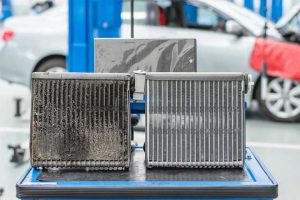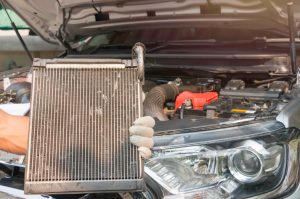Your car’s radiator plays a critical role in keeping the engine cool by allowing heat from the coolant to dissipate into the air. However, over time, the radiator fins — those thin strips of metal designed to maximize airflow — can become clogged with dust, insects, and debris. This buildup restricts airflow, reducing cooling efficiency and potentially leading to overheating.
Cleaning the radiator fins is a vital maintenance task, but it must be done carefully. These fins are delicate and can easily bend or break if handled roughly. Below, we’ll walk you through how to clean radiator fins properly, what tools to use, and how to maintain your radiator for optimal engine performance.
Why Clean Radiator Fins Regularly?

Dirty or bent fins can compromise the radiator’s ability to transfer heat. Overheating can shorten the lifespan of your engine and related components. Here are the main reasons to keep your radiator fins clean:
Benefits of Clean Radiator Fins:
-
Improved engine cooling efficiency.
-
Lower risk of overheating in hot weather or traffic.
-
Increased longevity of radiator and cooling system components.
-
Better air conditioning performance.
-
Reduced strain on the cooling fan and water pump.
Signs Your Radiator Needs Cleaning
| Symptom | Possible Cause | Severity |
|---|---|---|
| Engine temperature higher than usual | Dust and debris blocking fins | High |
| A/C performance reduced | Clogged radiator affecting condenser | Medium |
| Visible dirt or bugs on radiator surface | Airflow obstruction | Medium |
| Fan runs constantly | Poor ventilation | High |
| Overheating in stop-and-go traffic | Insufficient airflow | High |
If you observe one or more of these symptoms, it’s time to inspect and clean the radiator fins.
Tools and Materials Needed
Before you start, gather the right tools. Avoid harsh chemicals or high-pressure water — these can cause more harm than good.
You’ll Need:
-
Soft-bristle brush or paintbrush
-
Garden hose with a gentle spray nozzle
-
Mild detergent or radiator-safe cleaning solution
-
Spray bottle
-
Fin comb (or small flat screwdriver for minor straightening)
-
Microfiber cloths
-
Safety gloves and goggles
-
Compressed air (optional)
Avoid Using:
-
High-pressure washers — can bend or flatten fins.
-
Stiff metal brushes — can damage the aluminum surface.
-
Acidic cleaners — can corrode metal parts.
Step-by-Step Guide: How to Clean Radiator Fins Safely
Step 1: Cool Down the Engine
Always make sure the engine is completely cool before working on the radiator. Cleaning a hot radiator can cause burns or warping of the fins.
Step 2: Access the Radiator
-
Open the hood and locate the radiator at the front of the vehicle.
-
Remove any covers, grilles, or protective panels if necessary.
-
Inspect for leaks or corrosion before cleaning.
Step 3: Dry Cleaning (Optional)
If the radiator only has light dust buildup, you can use compressed air to clean it.
-
Blow air from the back side (engine side) toward the front.
-
Keep the nozzle 10–15 cm away to prevent bending the fins.
Step 4: Apply Cleaning Solution
-
Mix mild detergent with water in a spray bottle.
-
Spray the cleaner evenly over the fins from both sides (if accessible).
-
Let it sit for 5–10 minutes to loosen dirt and insects.
Step 5: Gentle Brushing
-
Use a soft-bristle brush to clean in the direction of the fins.
-
Avoid scrubbing sideways — this can bend the thin aluminum.
-
Work carefully to remove any visible buildup.
Step 6: Rinse the Radiator
-
Use a low-pressure water hose to rinse away debris.
-
Spray from the back to the front to push out loosened dirt.
-
Keep a distance of at least 30–40 cm to prevent damage.
Step 7: Straighten Bent Fins
Bent fins restrict airflow. Use a fin comb to realign them:
-
Gently insert the comb between the rows.
-
Move slowly and avoid applying excessive force.
Step 8: Dry the Radiator
-
Allow the radiator to air dry completely.
-
Alternatively, use compressed air to speed up drying — again, from a safe distance.
-
Reinstall covers or grilles once the radiator is fully dry.
Recommended Cleaning Frequency
| Driving Conditions | Recommended Cleaning Interval | Reason |
|---|---|---|
| City driving | Every 12 months | Dust and smog accumulation |
| Off-road or rural areas | Every 6 months | Mud and insect buildup |
| Hot, dry climates | Every 4–6 months | Fine dust accumulation |
| Cold/wet climates | Every 12–18 months | Less airborne debris |
Regular inspection and cleaning based on your driving conditions can greatly extend radiator life.
Maintenance Tips for Radiator Longevity
-
Avoid high-pressure cleaning — always use gentle water flow.
-
Check coolant levels regularly — low coolant can overheat the engine.
-
Inspect for corrosion or leaks — aluminum corrosion weakens the fins.
-
Keep the A/C condenser clean — it often sits in front of the radiator.
-
Use distilled water when mixing coolant to prevent mineral deposits.
-
Replace damaged fins or radiator units promptly to maintain efficiency.
If you need high-quality replacements or components for your cooling system, you can Buy Radiator & Components online. This includes radiators, caps, hoses, and other vital parts designed for reliable performance.
Common Mistakes to Avoid
| Mistake | Consequence | Prevention |
|---|---|---|
| Using a pressure washer | Bends or crushes fins | Use low-pressure hose |
| Cleaning when engine is hot | Burns and metal warping | Wait until engine cools |
| Using acidic or harsh cleaners | Corrosion of aluminum | Use mild detergent |
| Scrubbing sideways | Physical damage | Brush along the fin direction |
| Not drying radiator fully | Rust and trapped moisture | Air-dry before starting engine |
DIY vs. Professional Cleaning
| Aspect | DIY Cleaning | Professional Cleaning |
|---|---|---|
| Cost | Low — basic tools only | Moderate — service fee |
| Time Required | 45–60 minutes | 20–30 minutes |
| Risk of Damage | Medium if careless | Minimal |
| Effectiveness | Good for surface cleaning | Excellent for deep cleaning |
| When to Choose | Routine maintenance | Severe clogging or corrosion |
If the radiator is heavily clogged or corroded, professional cleaning may be the safer option. Mechanics use specialized equipment, like ultrasonic cleaners, to remove debris without damaging metal surfaces.
When to Replace the Radiator

Even with regular maintenance, radiators eventually wear out. You may need a replacement if:
-
Multiple leaks or cracks appear.
-
Fins are corroded or breaking apart.
-
Overheating persists even after cleaning.
-
The radiator core is rusted or clogged internally.
Replacing the unit restores full cooling efficiency and prevents costly engine repairs.
For durable, high-quality replacements, Buy Radiator & Components online — you’ll find a full range of compatible radiators, caps, hoses, and accessories.
Conclusion
Cleaning your car’s radiator fins is a simple yet vital part of vehicle maintenance. With careful handling, the right tools, and regular attention, you can keep your cooling system performing efficiently and avoid costly overheating issues.
Remember: gentle cleaning, not aggressive scrubbing, is the key to success. Keep your radiator in top condition, and your engine will reward you with smoother, cooler, and more reliable performance.
For replacement parts and accessories, always choose quality components — visit Buy Radiator & Components online to find everything needed for dependable cooling and long-lasting protection.